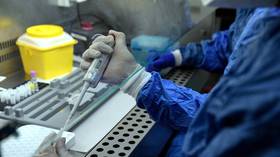US confirms first case of rare disease that spread in Europe
A Massachusetts man has been diagnosed with monkeypox after traveling to Canada, the Centers for Disease Control and Massachusetts Department of Public Health have confirmed on Wednesday.
While the agencies are working with the man’s healthcare providers and local health boards to identify anyone who had contact with him, they insist his case poses no risk to the public, and he is reportedly hospitalized and in good condition.
The case is the first to surface in the US this year and comes on the heels of an alert by Spanish authorities of a potential outbreak of the virus among 23 people in Madrid. While typically spread by respiratory transmission, a spokesperson for Madrid’s regional health department suggested the local outbreak was driven by “fluid contact,” noting that eight of the suspected cases were found in gay men.
Some 20 suspected cases of monkeypox also surfaced among Portuguese young men in and around Lisbon this week, and a number of similar cases have been confirmed in the UK. Of the seven UK cases confirmed as of Monday, four of the most recent were in gay or bisexual men, and the first involved a person who had recently been to Nigeria, where the infection was likely contracted.
Monkeypox has similarities with both smallpox, a deadly virus declared eradicated in 1980, and chickenpox, a common childhood disease. It begins with flu-like symptoms including fever, headache, muscle aches and swollen lymph nodes, before a rash emerges on the face and spreads to other body parts. While incurable, it is typically mild and sufferers usually recover within weeks.
There are two forms of monkeypox – a west African and a central African strain – and the current crop of cases are believed to be of the milder west African variety. Two cases of monkeypox were diagnosed last year in the US, both in people who had recently traveled to Nigeria.
The virus is difficult to spread, with transmission typically occurring through contact with bodily fluids and sores, contaminated clothing, or prolonged face-to-face contact leading to exchange of respiratory droplets.
You can share this story on social media:








Comments are closed.